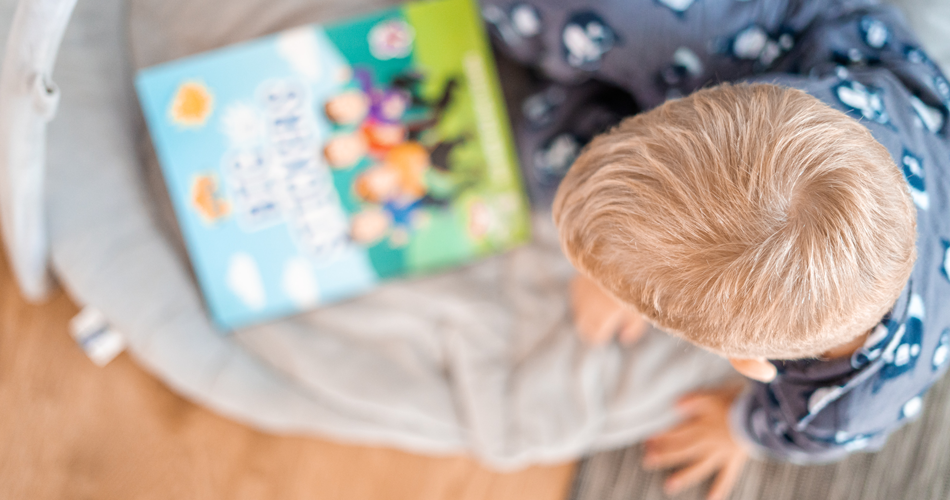The early learning environment is a hub of excitement and energy that includes spaces for young children to actively learn through different types of play. As important as it is to include a variety of stimulating activities for children, it’s just as important to include space for relaxation, comfort and being calm, often referred to as cozy areas.
The developers of the Early Childhood Environment Rating Scale define a cozy area as “a clearly defined space with a substantial amount of softness where children may lounge, daydream, read or play quietly.” The space must “provide enough soft furnishings to allow a child to completely escape the normal hardness of the typical early childhood classroom.” (Harms et al., 2014)
In addition to providing engaging and comforting learning spaces, it’s also important to stay vigilant about keeping the spaces clean and sanitary to reduce the spread of illness. So, how can you provide a soft and cozy area while limiting the spread of germs? Here are five tips to help you create clean, comforting spaces for children.
1. Select easy to clean materials
Choose furnishings made of materials that can be easily cleaned and sanitized. A soft mat or child-sized seating with vinyl cushions can be sprayed down just like tabletops and other high-touch items. These types of materials make cleaning and sanitizing quick and easy during a busy day. Swap difficult-to-clean soft materials with items that can be washed in a washing machine and dryer. If area rugs are used, select smaller rugs that can be laundered in a washing machine.
2. Communicate your cleaning schedule
For teachers who share caregiving duties in one space, develop a shared schedule for cleaning and sanitizing. Work together to determine the frequency of cleaning, sanitizing and laundering the cozy furnishings. A written checklist helps keep everyone on the same page. You can also let families know how you clean and sanitize the space. It will give them peace of mind to know what you’re doing to limit the spread of germs. For more information on cleaning and sanitizing, view the Arizona Quality First Recommendations for Safe Child Care Operations during COVID-19.
3. Keep it quiet and calming
A cozy area should be separate and distinct from active play spaces. Consider the placement of the cozy area and provide physical separation and distance away from the louder, active spaces. It may be helpful to provide books or other quiet activities in the cozy space to help children understand the purpose of the area. Coziness can also be conveyed with other visual features such as muted colors, sunlight and soft lighting.
4. Keep soft items in good repair
Since cozy furnishings are often very popular and frequently used, it’s important to keep an eye out for wear and tear issues. Check these items regularly for loss of softness, rips, exposed stuffing or other problems that can emerge over time. This is important to check since some repair issues can also cause problems with keeping items clean and sanitary. Make a habit of having items repaired or replaced as needed, so coziness and cleanliness can be maintained.
5. Incorporate familiar faces
In addition to cozy spaces, young children find comfort in seeing familiar faces during their school day. Encourage families to send copies of family photos, including immediate and extended family members. Make photos accessible to children by hanging them on the wall, displaying in child-safe frames on a low shelf or by creating albums of family photos that children can reach and look through independently. These can be included within the cozy area or other spaces in the classroom.
As you work to provide a comforting space for the children in your care, we hope you will take comfort in the knowledge that you don’t need to do it alone. If you are a Quality First participant, your coach is available to provide expert guidance, support and assistance using virtual video conferencing platforms or in-person visits, depending on agency guidelines and following agency protocols for health and safety.
Your coach can help you plan new ways of providing comforting spaces for relaxation for the children in your care. If you are not a Quality First participant, we invite you to apply today. While you await selection, you’ll receive information, tips and opportunities by email to help you make quality improvements that will make a difference for the children in your care.
At Quality First, we love to hear from you. Share your new and innovative practices so others can be inspired. Send an email to QualityFirst@FirstThingsFirst.org.
References
Harms, T., Clifford, R., & Cryer, D. (2014). Early Childhood Environment Rating Scale (ECERS-3). Teachers College Press
